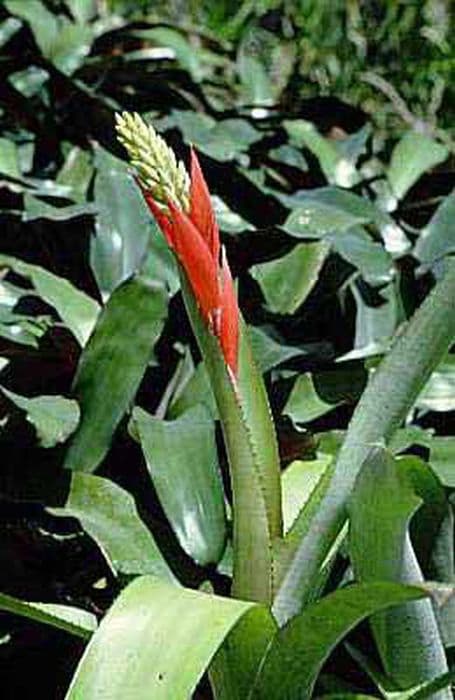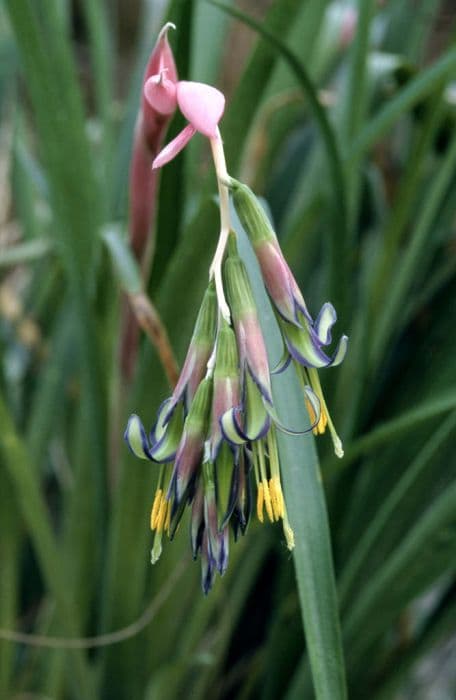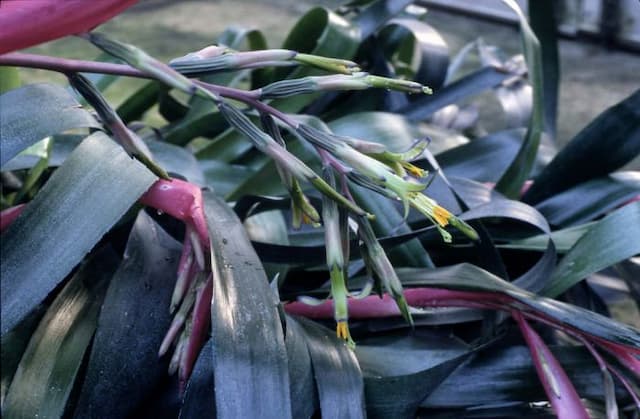Air Plant Tillandsia bergeri

ABOUT
Tillandsia bergeri, commonly known as air plant, is a unique and attractive plant with a distinctive look. It clings to life in a variety of conditions without the need for soil, getting water and nutrients through its leaves from the air. Its appearance is characterized by a rosette of thin, silvery-green leaves that are covered in tiny scales known as trichomes. These trichomes give the leaves a fuzzy feel and a somewhat frosted appearance which helps the plant absorb moisture from the air. The leaves of the air plant twist and curl as they grow, creating an interesting and often irregular shape. The plant's leaves may appear stiff or slightly arching, forming a somewhat spiky silhouette. When it blooms, the air plant produces a long-lasting flower spike that can bear tubular flowers, adding a pop of color which contrasts strikingly with the muted tones of the foliage. The blossoms typically come in shades of pink, purple, or blue, depending on the variety. After flowering, the air plant may produce offsets or "pups," which grow at the base of the parent plant, eventually forming a clump of individual plants nestled together. This clumping habit is part of its charm, as it creates a more dramatic visual impact and showcases the plant's full beauty. The air plant's versatility and unique structure make it a favorite among enthusiasts of indoor gardening and those looking to add a touch of greenery without the mess of potted plants. It's often displayed in glass terrariums, mounted on pieces of wood, or simply placed in a bright spot where its ornamental qualities can be fully appreciated.
About this plant
 Names
NamesFamily
Bromeliaceae
Synonyms
Berger's Air Plant, Air Plant
Common names
Tillandsia bergeri.
 Toxicity
ToxicityTo humans
Tillandsia bergeri, commonly known as Air Plant, is not known to be toxic to humans. As such, there are no specific symptoms of poisoning associated with ingestion of this plant. However, it is generally not advisable to eat ornamental plants due to the potential for non-toxic adverse reactions or the presence of harmful pesticides.
To pets
Tillandsia bergeri, commonly known as Air Plant, is not known to be toxic to pets either. It is unlikely to cause any symptoms of poisoning if ingested by pets such as cats and dogs. Still, it's best to prevent pets from chewing on houseplants as a general precaution and to avoid any digestive upset or other unforeseen issues.
 Characteristics
CharacteristicsLife cycle
Perennials
Foliage type
Evergreen
Color of leaves
Green
Flower color
Purple
Height
6 inches (15 cm)
Spread
6 inches (15 cm)
Plant type
Bromeliad
Hardiness zones
9
Native area
Argentina
Benefits
 General Benefits
General Benefits- Low Maintenance: Tillandsia bergeri (also known as Berger's air plant) requires minimal watering and no soil, making it easy to care for.
- Indoor & Outdoor Versatility: It can thrive both indoors and outdoors in suitable climates, providing flexibility in placement.
- Decorative Appeal: With its unique appearance and growth pattern, it adds an artistic touch to any environment.
- Space Efficiency: As it doesn't need soil, it can be placed in small or unconventional spaces, perfect for compact living areas.
- Propagation Ease: It propagates easily through offsets (pups), allowing for natural expansion or sharing with others.
- Stress Reduction: Like many plants, it contributes to a calming environment, which can reduce stress.
 Medical Properties
Medical PropertiesThis plant is not used for medical purposes.
 Air-purifying Qualities
Air-purifying QualitiesThis plant is not specifically known for air purifying qualities.
 Other Uses
Other Uses- Artistic Jewelry: Tillandsia bergeri can be incorporated into unique pieces of jewelry, such as necklaces or earrings, due to their small size and interesting textures.
- Education: These plants can be used in classrooms or educational workshops to teach about epiphytic plants and their adaptations to living without soil.
- Wedding Favors: Their small size and low maintenance make Tillandsia bergeri a popular and unique wedding favor for guests to take home and care for.
- Photography Props: Due to their unusual appearance, they are often used as interesting subjects or accents in macro photography.
- Christmas Ornaments: Tillandsia bergeri can be attached to ornaments and used as natural, eco-friendly decorations during the festive season.
- Keychains: Small specimens can be turned into living keychains, providing a touch of greenery on the go.
- Wearable Corsages: For proms, weddings, or other formal events, these air plants can be used to create living corsages.
- Fridge Magnets: When attached to a small magnet, they can turn a refrigerator door into a vertical garden space.
- Bookmarks: Thin and dry specimens can be used as organic bookmarks that bring a bit of nature into reading routines.
- Biodegradable Confetti: When their leaves or petals fall, they can be collected and used as eco-friendly confetti for outdoor celebrations.
Interesting Facts
 Feng Shui
Feng ShuiThe Air plant is not used in Feng Shui practice.
 Zodiac Sign Compitability
Zodiac Sign CompitabilityThe Air plant is not used in astrology practice.
 Plant Symbolism
Plant Symbolism- Resilience: Air plants like Tillandsia bergeri don’t need soil to grow, which symbolizes the ability to survive and adapt to challenging conditions.
- Freedom: Since they are not rooted in soil, Air plants represent independence and an unbound spirit, thriving in various environments.
- Air purification: Tillandsia bergeri, like many air plants, are believed to help clean the air, symbolizing purity and improvement of surroundings.
- Uniqueness: With their distinct appearance, Air plants symbolize individuality and the beauty in standing out from the crowd.
 Water
WaterAir plants like Tillandsia bergeri, commonly known as Berger's air plant, should be watered by misting them two to three times per week. During prolonged dry periods or in particularly hot climates, increasing watering to four times per week may be beneficial. A thorough soak is recommended every two weeks by submerging the plant in water for 1 hour. Allow the Berger's air plant to dry completely after soaking before placing it back in its spot.
 Light
LightBerger's air plant thrives in bright, indirect sunlight. Position the plant within 3 to 5 feet of a window where it can receive plenty of light but is not exposed to direct sun, which can cause its leaves to burn. A spot that receives filtered light through sheer curtains is ideal for this air plant.
 Temperature
TemperatureBerger's air plant does well in temperatures ranging from 50 to 90 degrees Fahrenheit. It can survive short periods outside this range but should not be exposed to temperatures below 45 degrees Fahrenheit as it can damage the plant. The ideal temperature range for maintaining healthy growth is between 60 and 80 degrees Fahrenheit.
 Pruning
PruningPruning Berger's air plant is generally done to remove any brown or dead leaves to keep the plant looking tidy and encourage better growth. Using a pair of sharp scissors, gently cut the undesirable parts without damaging the healthy tissue. Pruning is best done after the plant has been watered, as the leaves are more flexible, and it's typically not needed more than once or twice a year.
 Cleaning
CleaningAs needed
 Soil
SoilTillandsia bergeri, commonly known as air plant, does not require soil as it absorbs moisture and nutrients through its leaves. Instead, it thrives when mounted on a substrate like bark or driftwood, or simply placed amongst decorative stones. A soil mixture is unnecessary, but ensuring a pH range of 5.5 to 6.0, if planted in a container with soil, is beneficial for its growth.
 Repotting
RepottingTillandsia bergeri, or air plant, does not need traditional repotting. It is an epiphyte and can grow without soil by attaching to a supportive structure. It should be mounted or placed in a location where air circulation is good, avoiding the need for repotting. Repotting is not applicable to this type of plant.
 Humidity & Misting
Humidity & MistingAir plants like Tillandsia bergeri prefer high humidity environments, typically around 50-70%. They absorb moisture from the air, so environments with suitable humidity are essential for their health. Spraying or misting the plants can help maintain humidity if the surrounding air is dry.
 Suitable locations
Suitable locationsIndoor
Mount on driftwood or place in bright, indirect light.
Outdoor
Hang in shades; mist regularly; protect from frost.
Hardiness zone
9-11 USDA
 Life cycle
Life cycleTillandsia bergeri, commonly known as Berger's air plant, begins its life cycle as a seed, which germinates into a small seedling with tiny scales that help it absorb moisture from the air. As it matures, the seedling grows into a rosette of silver-green leaves through a phase of vegetative growth, taking nutrients and water from the air and occasional rain. The plant will eventually reach maturity and produce a flower spike, bearing attractive and bright blooms, signaling the reproductive stage. Following pollination, often by birds or insects, the flowers will develop into seed pods that burst open to release seeds, thereby completing the sexual reproduction cycle. Simultaneously, Berger's air plant may produce pups, or offsets, around the base of the mother plant, a form of asexual reproduction, which will grow independently once the parent plant begins to die off after flowering. The lifecycle continues with these pups taking over as the next generation, growing to maturity to repeat the process.
 Propogation
PropogationPropogation time
Spring-Summer
Tillandsia bergeri, commonly known as the Air Plant, is mostly propagated through the division of offsets, also known as "pups." These pups are small replicas of the parent plant that grow at its base after the parent has flowered. Once they have reached about one-third of the size of the parent plant, they can be gently pulled away by tugging them from the base. Care should be taken not to damage the pup or the mother plant. The separated pup can then be placed on a suitable substrate where it can take root and grow independently. This method is favored for its simplicity and effectiveness, making it a popular way to multiply Air Plants and share them with others.









